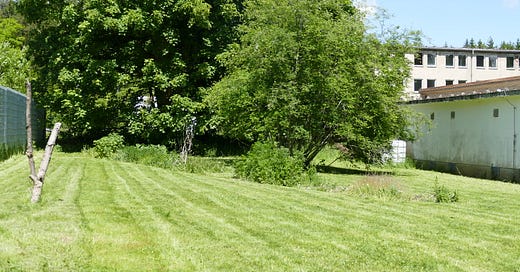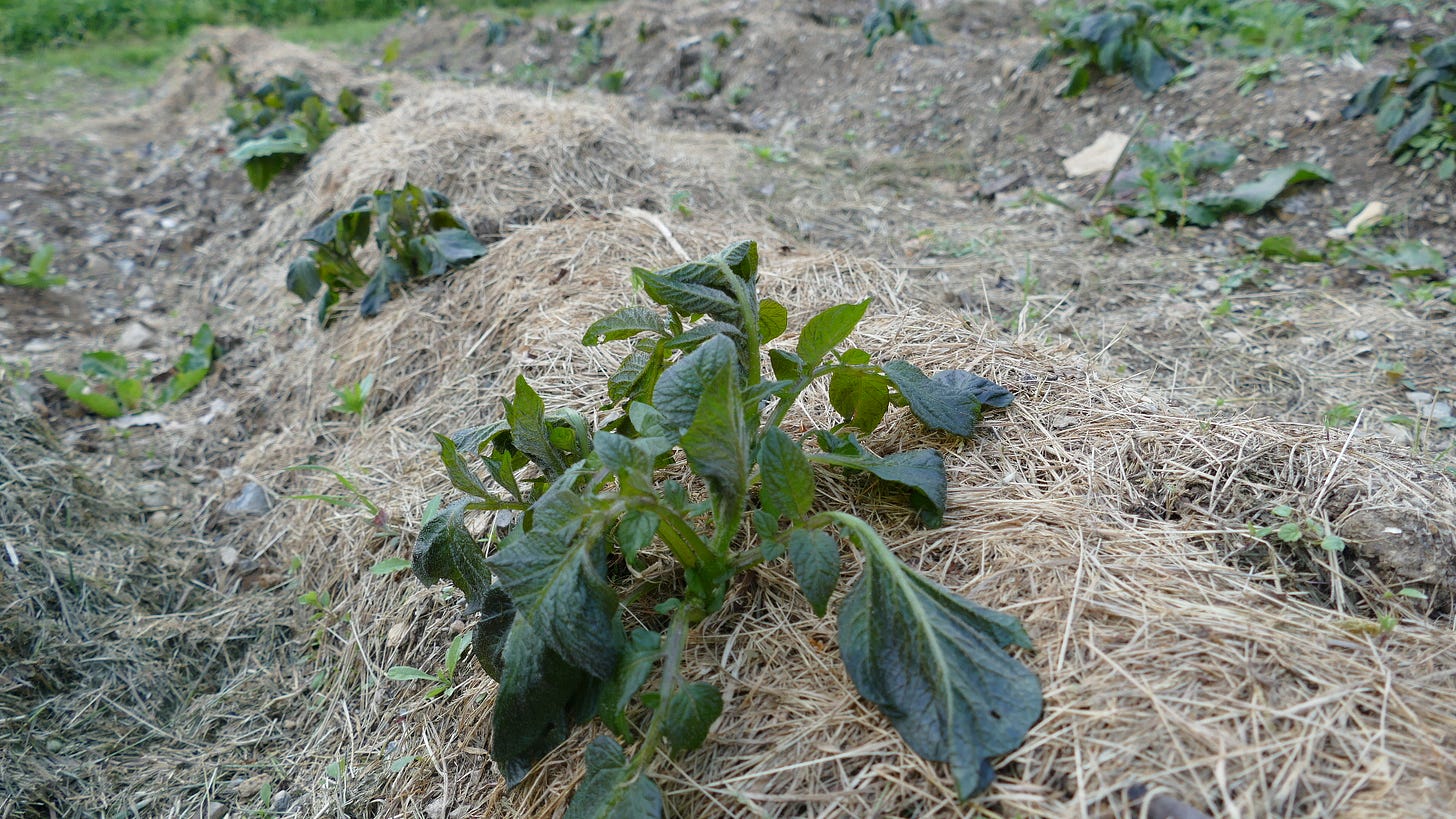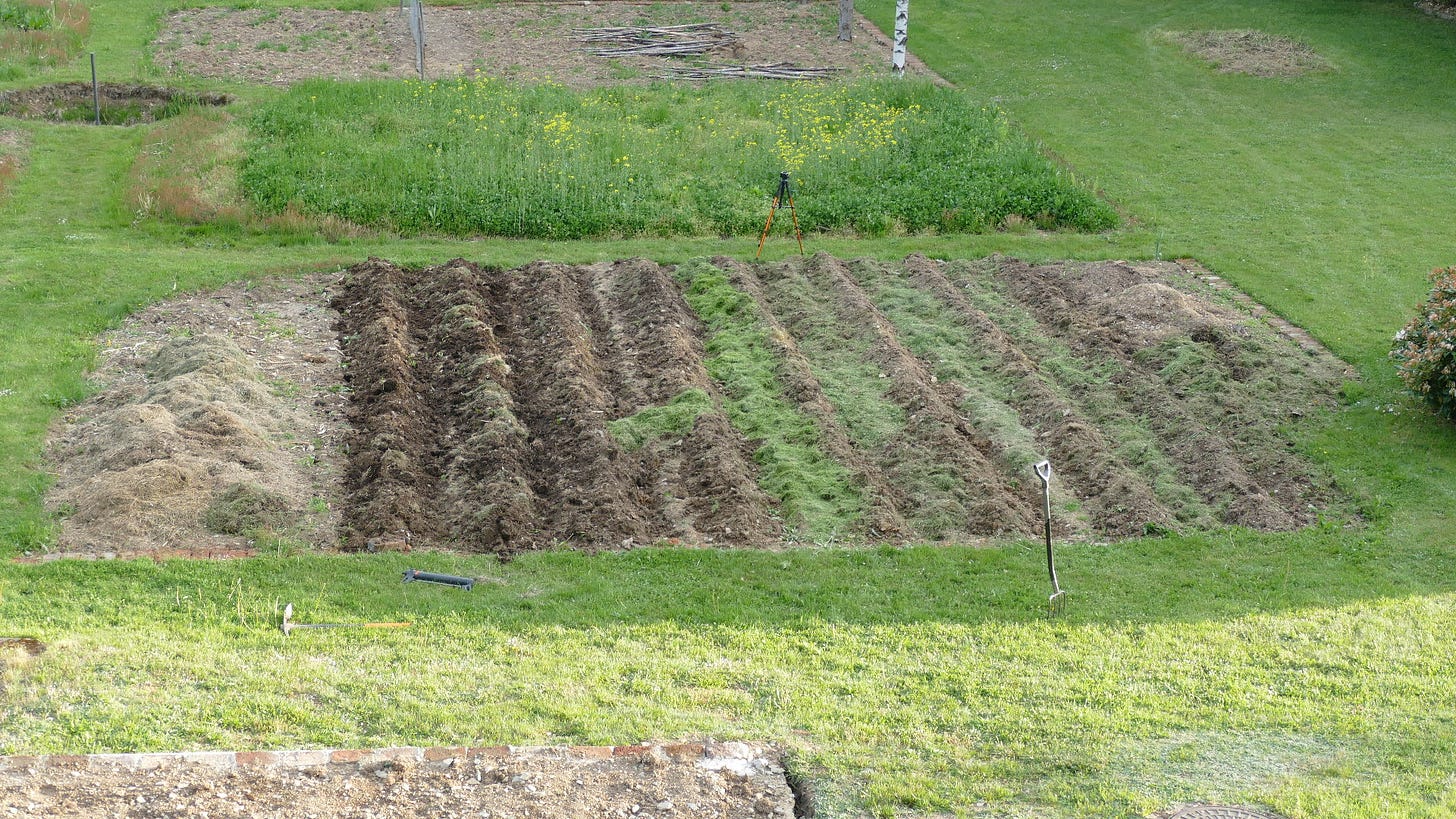One kilometre of fencing separates The Barracks from the outside world. Around a half of it is steadily rotting larch palisade strung between the original reinforced concrete posts spaced 2.4m apart The rest is a cheap metal large wire mesh of the sort that is hastily erected to delineate a building site, supported by heavy concrete moulded feet. At just under two meters tall, I have seen them cleared by a startled young deer in a single, panicked leap.
This perimeter creates a more or less circular space of some 55,000 square meters (5.5 hectares) or 600,000 square feet (13.5 acres).
In the first few months of moving in, I beat the bounds as an almost daily ritual, learning and feeling the space. I still do this a few times a year. I always find a new gap to be repaired, but I walk it for the slow ceremony of unity between pirate and his island rather than as inspection. Replacing the wooden sections, even as they deteriorate, is mostly beyond the current budget and not very effective against the ingress of wild boar anyway. I mostly string a game-proof fence behind it, sealing it from the searching snouts of the pigs which are very welcome in the forest, but most unwanted where the vegetables grow and where they are legally and sensibly not allowed to mix with Tony, Brunhilda and Marilyn.
Around one hectare is under roads and buildings. One is swamp and lake, although the alder planting episode of five or six years ago is slowly reclaiming a portion of that. The original hectare of forest is expanding slowly through 1.5 and heading towards two. That leaves between one and two hectares which could be said to be under direct interventionist control. The sportplatz, edged by Old House on one side and the incised gullies of caterpillar tracks and armoured vehicles on two others, and the orchard over on the north side of Big House are by far the most extensive areas, and with around 2000m2 of the remainder being cultivated, it means that by far the biggest single biotope is grass.
Grassland is an only ever an intermediate in nature. Left alone, it is the first move towards land reclamation by forest. From pseudo-chaotic flower meadows to tramline-clipped show lawns, every patch of grass require human intervention to hold the line against the plant world’s apex predator - the tree. You can send in the grazing herbivores; sheep, cows and goats; or you can mow.
I mow.
Throughout spring, I mow for at least two hours on every dry day. I would do more, but that is the most the mower should be subjected to, and the least possible to stay on top of it.
The lawnmower is low and sleek, accidentally streamlined, cowled with polished black plastic, details and decals in blue and red. The engine, a pull-start auto-choked Honda four stroke. It is adorned with two yellow stickers courtesy of the German Standards Institute and detail a wide selection of hazards and the normed, standardised value of the loudness output of 95 decibels.1
The white noise of lawn mowing, the repetitive up and down, diagonal stripes, endless concentric circles. The engine buzzes, time passes. No longer a weekend chore for unwilling teenagers, released by meditative repetition the mind empties. Eventually, an ordered chromatic boundary emerges, contrasting even expanse of lime green lawn undercutting dark malachite conifer branches almost, not quite touching. A quiet triumph of clean contrast and fleeting perfection.
It is a solitary undertaking, but never a lonely one. Woodpeckers chilling on the ground spring up like startled missiles, flying fast and low. Pied wagtails dart in and out, snatching insects from the most freshly mown clippings and blackbirds and thrushes come the closest, inquisitive and chatty.
Every scything of the blades is an act of photosynthetic theft, sunshine is turned into biomass, capturing carbon and concentrating it at and below ground level. The energy of the sun and the carbons of the air sucked into the mower and heaped into piles.
There is no
more effective ledger entry in my carbon budget than the power of harvesting grass and turning it through intermediates into rich, nurturing soil. Pigs eat it and trample it into the ground, compost piles grow by cubic meters and heavy mulches feed the invertebrate hosts of the vegetable patch, all microsteps to a better world.
I mow because it creates beauty, because it is necessary and because it feeds the soil in multiple ways.
Mostly, I mow because it works.
Your loving Pirate Ben
xoxo
Is there a unit of measurement more complex and unintuitive than the decibel. It is not an SI unit (that would be the W/m²), and it is given in its standard form as a number expressed as a tenth of a unit - the bel (B). A copy and paste of the definition of the Bel looks like this - one bel is equal to the decadic logarithm of a ratio between two power quantities of 10:1, or the decadic logarithm of a ratio between two root-power quantities of √10:1. With some struggle, I think I understand that in a mathematical sense, but intutively it is meaningless. Anyway, watts per meter squared at least gives a notion that it is the power of a thing, but what is sound doing in meters squared? Why is that not cubed? And if it is a logarithmic ratio, how does it have units anyway?







If I imagine myself pushing your mower through the vast sections of grass on your property, I believe I would consider it meditative. It would become an act of deep connection with nature - a sort of truce between what I want and what nature demands. I imagine it as a beautiful act...for one day! Doing it every single day would quickly feel like a chore...a tussle with nature that I would forever lose. Kudos to you and your endless energy and patience...
I did put the same picture in twice, didn't I?
WAKE UP!! :)